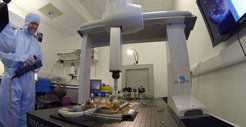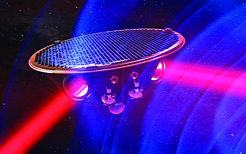LISA Pathfinder displayed for the first time at the ILA 2014
First steps towards gravitational wave detection in space
Direct detection of gravitational waves in space requires some completely new technologies. ESA created the LISA Pathfinder mission to develop and prove the technologies that cannot be verified on the ground. From May 20 – 25, a LISA Pathfinder model will be displayed for the first time in the Space Pavilion (Hall 4) of the ILA Berlin Air Show 2014. LISA Pathfinder will be launched in 2015 and pave the way for the future space-based gravitational-wave observatory eLISA.

“We are running the last tests before the instruments are mounted in the satellite body. LISA Pathfinder will be launched in about a year, so we are very excited – the LISA Pathfinder Mission will bring us a significant step closer to realizing a gravitational-wave observatory in space“, says Prof. Dr. Karsten Danzmann, director at the Max Planck Institute for Gravitational Physics (Albert Einstein Institute/AEI) and head of the Institute for Gravitational Physics at the Leibniz Universität Hannover.
LISA Pathfinder
will place two test masses in a nearly perfect gravitational free-fall and will control and measure their motion with unprecedented accuracy. This is achieved through state-of-the-art technology comprising inertial sensors, a laser metrology system, a drag-free control system and an ultra-precise micro-propulsion system. All these technologies are essential not only for eLISA – they also lie at the heart of any future space-based test of Einstein's theory of General Relativity. In essence: For LISA Pathfinder one laser arm of the planned large gravitational wave mission eLISA, is reduced from millions of kilometres to 40 cm to fit into the LISA Pathfinder spacecraft.
Paving the way for a new astronomy

LISA Pathfinder is paving the way for the large-scale space mission eLISA designed to detect one of the most elusive phenomena in astronomy – gravitational waves. Extreme precision is required to detect the tiny ripples in the fabric of space and time predicted by Albert Einstein. A direct detection of gravitational waves will add a new sense to our perception of the Universe: for the first time we will be able to LISTEN to the Universe because gravitational waves are similar to sound waves. Hence gravitational wave astronomy will complement our understanding of the Universe and its evolution. Gravitational waves measured by a large mission in space will allow us to e.g. trace the formation, growth, and merger history of massive black holes. It will also enable us to confront General Relativity with observations, and it will probe new physics and cosmology with gravitational waves. Together with other astronomical methods and the gravitational wave observatories on earth eLISA will discover the so-called dark side of the universe and gather revolutionary information.
International collaboration
LISA Pathfinder is an ESA led mission. It involves European space companies and research institutes from France, Germany, Italy, The Netherlands, Spain, Switzerland and UK and the US space agency NASA.
The concept and details of the optical system for LISA Pathfinder have been developed at the AEI in Hanover, Germany. Its director Karsten Danzmann is Co-Principal Investigator of the mission and shares the scientific leadership with Stefano Vitale, University of Trento, Italy.













